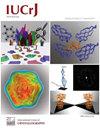High-quality ultra-fast total scattering and pair distribution function data using an X-ray free-electron laser
IF 3.6
2区 材料科学
Q2 CHEMISTRY, MULTIDISCIPLINARY
引用次数: 0
Abstract
This work demonstrates that high-quality ultra-fast total scattering data and pair distribution function data can be obtained from a single ∼30 fs pulse at the European XFEL, achieving a record Q range of up to 16.6 Å−1. These results establish XFELs as powerful tools for probing atomic scale structures on ultra-fast timescales, opening new opportunities for studying dynamic processes in disordered and complex materials.
High-quality total scattering data, a key tool for understanding atomic-scale structure in disordered materials, require stable instrumentation and access to high momentum transfers. This is now routine at dedicated synchrotron instrumentation using high-energy X-ray beams, but it is very challenging to measure a total scattering dataset in less than a few microseconds. This limits their effectiveness for capturing structural changes that occur at the much faster timescales of atomic motion. Current X-ray free-electron lasers (XFELs) provide femtosecond-pulsed X-ray beams with maximum energies of ∼24 keV, giving the potential to measure total scattering and the attendant pair distribution functions (PDFs) on femtosecond timescales. We demonstrate that this potential has been realized using the HED scientific instrument at the European XFEL and present normalized total scattering data for 0.35 Å−1 < Q < 16.6 Å−1 and their PDFs from a broad spectrum of materials, including crystalline, nanocrystalline and amorphous solids, liquids and clusters in solution. We analyzed the data using a variety of methods, including Rietveld refinement, small-box PDF refinement, joint reciprocal–real-space refinement, cluster refinement and Debye scattering analysis. The resolution function of the setup is also characterized. We conclusively show that high-quality data can be obtained from a single ∼30 fs XFEL pulse for multiple different sample types. Our efforts not only significantly increase the existing maximum reported Q range for an S(Q) measured at an XFEL but also mean that XFELs are now a viable X-ray source for the broad community of people using reciprocal-space total scattering and PDF methods in their research.
使用x射线自由电子激光器的高质量超快速总散射和对分布函数数据。
高质量的总散射数据是理解无序材料原子尺度结构的关键工具,需要稳定的仪器和高动量转移。这是现在使用高能x射线束的专用同步加速器仪器的常规操作,但在不到几微秒的时间内测量总散射数据集是非常具有挑战性的。这限制了它们捕捉在原子运动的更快时间尺度上发生的结构变化的有效性。目前的x射线自由电子激光器(XFELs)提供了最大能量为~ 24 keV的飞秒脉冲x射线束,有可能在飞秒时间尺度上测量总散射和伴随的对分布函数(pdf)。我们利用欧洲自由电子激光器的HED科学仪器证明了这一潜力,并提供了0.35 Å-1 < Q < 16.6 Å-1的归一化总散射数据及其pdf,这些数据来自广泛的材料,包括晶体,纳米晶体和非晶固体,液体和溶液中的团簇。采用Rietveld细化、小盒PDF细化、联合互实空间细化、聚类细化和Debye散射分析等多种方法对数据进行分析。对该装置的分辨率函数也进行了表征。我们最终证明,对于多种不同的样品类型,可以从单个~ 30 fs的XFEL脉冲中获得高质量的数据。我们的努力不仅显著提高了在XFEL上测量S(Q)的现有最大Q范围,而且还意味着XFEL现在是一个可行的x射线源,广泛的社区使用互向空间总散射和PDF方法在他们的研究中。
本文章由计算机程序翻译,如有差异,请以英文原文为准。
求助全文
约1分钟内获得全文
求助全文
来源期刊

IUCrJ
CHEMISTRY, MULTIDISCIPLINARYCRYSTALLOGRAPH-CRYSTALLOGRAPHY
CiteScore
7.50
自引率
5.10%
发文量
95
审稿时长
10 weeks
期刊介绍:
IUCrJ is a new fully open-access peer-reviewed journal from the International Union of Crystallography (IUCr).
The journal will publish high-profile articles on all aspects of the sciences and technologies supported by the IUCr via its commissions, including emerging fields where structural results underpin the science reported in the article. Our aim is to make IUCrJ the natural home for high-quality structural science results. Chemists, biologists, physicists and material scientists will be actively encouraged to report their structural studies in IUCrJ.
 求助内容:
求助内容: 应助结果提醒方式:
应助结果提醒方式:


